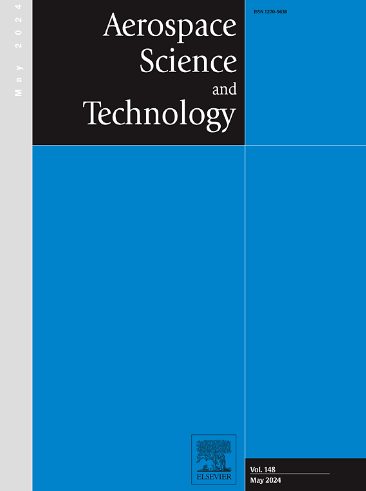Experimental and computational investigations of flexible membrane nano rotors in hover
IF 5
1区 工程技术
Q1 ENGINEERING, AEROSPACE
引用次数: 0
Abstract
With reduced size, the flight Reynolds number of the nano rotor decreases, leading to a sharp drop in the aerodynamic efficiency of the nano rotor. Therefore, improving the aerodynamic performance of the nano rotor at low Reynolds numbers through flow control methods becomes imperative. In this study, from the perspective of bionics, flexible materials are employed in nano rotor design. Seven different layouts of flexible membrane rotor blades are designed and fabricated. The influence of leading and trailing edge flexibility, as well as membrane occupancy ratio on rotor blade propulsion characteristics, is explored through propulsion performance tests in hover.
Results show that among several layouts proposed in this study, the layout with both reinforced leading and trailing edges of the flexible membrane nano rotor blade exhibits excellent propulsive performance. However, the propulsion performance of the flexible membrane rotors doesn't vary linearly with the ratio of membrane area to the whole rotor area. The appropriate ratio or flexibility can increase the propulsive performance of the rotor, especially at medium and high collective angles. At 7000 RPM and a 20° collective angle, the Figure of Merit of the flexible membrane nano rotor increases up to 4.2% when comparing with the nano rotor without membrane. This improvement becomes more significant with higher collective angles. The structural natural vibration characteristics of each flexible membrane with different layouts are analyzed through modal tests, ensuring the accuracy of the finite element model for flexible membrane rotors. Numerical analysis of the fluid-structure coupling of a flexible membrane rotor with different layouts indicates that rotor structural vibrations is highly consistent with fluctuation of aerodynamic parameters. The deformation of the flexible membrane under aerodynamic forces enhances local blade camber, but reduces angles of attack. This, subsequently, minimizes the size of laminar separation bubbles and the intensity of the blade tip vortices at high collective angles. Consequently, rotor power coefficients decrease, and overall aerodynamic performance improves.
悬停中柔性膜纳米转子的实验和计算研究
随着尺寸的减小,纳米转子的飞行雷诺数也随之降低,导致纳米转子的气动效率急剧下降。因此,通过流动控制方法改善纳米转子在低雷诺数下的气动性能势在必行。本研究从仿生学的角度出发,在纳米转子设计中采用了柔性材料。研究人员设计并制造了七种不同布局的柔性膜转子叶片。结果表明,在本研究提出的几种布局中,柔性膜纳米转子叶片的前缘和后缘均经过强化的布局表现出优异的推进性能。然而,柔性膜转子的推进性能并不随膜面积与整个转子面积之比呈线性变化。适当的比例或柔性可以提高转子的推进性能,尤其是在中高集合角时。在转速为 7000 转/分钟、集合角为 20°的条件下,柔性膜纳米转子的优越性能比无膜纳米转子提高了 4.2%。随着集合角的增大,这种改善变得更加明显。通过模态试验分析了不同布局的柔性膜的结构自然振动特性,确保了柔性膜转子有限元模型的准确性。对不同布局柔性膜转子流固耦合的数值分析表明,转子结构振动与气动参数波动高度一致。柔性膜在空气动力作用下的变形会增强叶片的局部外倾,但会减小攻角。这样,层流分离气泡的大小和高集合角下叶尖涡流的强度就会减到最小。因此,转子功率系数降低,整体气动性能提高。
本文章由计算机程序翻译,如有差异,请以英文原文为准。
求助全文
约1分钟内获得全文
求助全文
来源期刊

Aerospace Science and Technology
工程技术-工程:宇航
CiteScore
10.30
自引率
28.60%
发文量
654
审稿时长
54 days
期刊介绍:
Aerospace Science and Technology publishes articles of outstanding scientific quality. Each article is reviewed by two referees. The journal welcomes papers from a wide range of countries. This journal publishes original papers, review articles and short communications related to all fields of aerospace research, fundamental and applied, potential applications of which are clearly related to:
• The design and the manufacture of aircraft, helicopters, missiles, launchers and satellites
• The control of their environment
• The study of various systems they are involved in, as supports or as targets.
Authors are invited to submit papers on new advances in the following topics to aerospace applications:
• Fluid dynamics
• Energetics and propulsion
• Materials and structures
• Flight mechanics
• Navigation, guidance and control
• Acoustics
• Optics
• Electromagnetism and radar
• Signal and image processing
• Information processing
• Data fusion
• Decision aid
• Human behaviour
• Robotics and intelligent systems
• Complex system engineering.
Etc.
 求助内容:
求助内容: 应助结果提醒方式:
应助结果提醒方式:


